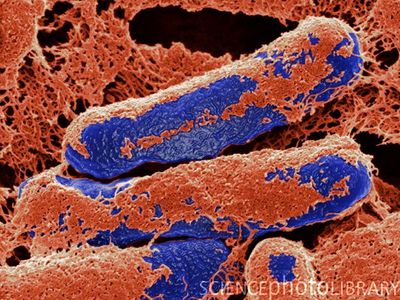Clostridium botulinum neu2011
Clostridium botulinum

Classification
Taxonomic Classification for Clostridium botulinum
Kingdom: Bacteria
Phylum: Firmicutes
Class: Clostridia
Order: Clostridiales
Family: Clostridiaceae
Genus: Clostridium
Species: botulinum
Description
Clostridium botulinum is a rod-shaped, gram positive bacteria that produces heat and chemical resistant endospores. The bacterium is a soil dwelling anaerobe that produces a known neurotoxin. The symptoms of botulism were first described by Justinus Kerner in the early 1820's. Kerner named the disease botulism after the Latin word for sausage, owing to the fact that much of the food poisoning was attributed to the undercooked breakfast meat.
There are seven identified toxins produced by an equal number of strains of the C. botulinum, types A-G. Each strain when cultured has produced toxins of different specificities.
Genome
The complete genome of the A strain of the C. botulinum was sequenced in May 2007. The chromosome found in this organism is a circular model of DNA. The complete chromosome of the bacteria is 3,886,916 nt. In the organism there are 3,776 genes, 81% of which are coding genes. Similar to other members of the Clostridium genus, there is a low cytosine-guanine, 28% in C. botulinum.
Cell Structure and Metabolism
Clostridium botulinum is a gram-positive rod-shaped bacteria that forms vegetative endospores. The bacteria is a obligate anaerobe and uses fermentation patterns of carbohydrates and nitrogenous substrates.
Ecology
C. botulinum is most commonly found in the soil and freshwater sediment. The bacteria also can live in animal intestines and be found in animal feces. The endospores of C. botulinum can be found in numerous environments, various foods and sewage due to their resistant nature. The spores of the bacteria are not usually found in human feces unless the human has contracted boltulism.
C. botulinum has been isolated all over the world, on every continent but Antarctica, and at both very deep and very high altitude ranges (below 6400ft up to 11,000ft).
The reproduction of endospores requires non-halophilic salinities and anaerobic conditions.
Pathology
The most common occurrences botulism poisoning is caused ingestion of a toxin that is produced by the Clostridium botulinum bacteria. There are three types of botulism poisoning, the most common is from ingestion of the bacterial spores. Other types include wound botulism, where open wounds can become colonized by the bacteria. The third type of poisoning is infant botulism, where infants can inject the bacterial spores and suffer from the symptoms of the toxin. The toxin is a neuro-active high molecular weight protein, which comes in seven different variations, types A through G. The seven different strains are separated mainly by location. Type A botulism poisoning is most commonly seen in the northern parts of Europe and the western US, Type B is commonly seen in the eastern United States. Types C and D are pathologic only in animals and do not effect human. Botulism type E is found in fresh water sediments around the world. Type F of the toxin is not produced by C. botulinum, but another species, Clostridium baratii.
If food containing spores of this organism is ingested, the bacteria can grow and produce the toxins which are then taken up by the body. The symptoms of the toxin do not manifest until about one to two months after the ingestion of the contaminated food. It starts by affecting several groups of nerves in the head. This can show up as drooping eyes, loss of facial expression and problems chewing and swallowing. The paralysis is descending and spreads to the rest of the body. The toxin effects not only voluntary muscles, but also the involuntary muscles. This can manifest in respiratory problems. The toxin also affects various parts of the autonomic nervous system. This can lead to symptoms such as dry mouth, and hypotension, and constipation. Overall the most clinically recognized symptoms are descending paralysis, lack of fever, and clear mental abilities.
Current Research
Sources
- http://www.ncbi.nlm.nih.gov/Taxonomy/Browser/wwwtax.cgi?mode=Info&id=1491&lvl=3&keep=1&srchmode=1&unlock&lin=s
- http://www.sciencedirect.com/science?_ob=ArticleURL&_udi=B6TCS-43VJ7K0-9&_user=2403224&_coverDate=11%2F30%2F2001&_rdoc=1&_fmt=high&_orig=search&_origin=search&_sort=d&_docanchor&view=c&_searchStrId=1637460128&_rerunOrigin=scholar.google&_acct=C000057194&_version=1&_urlVersion=0&_userid=2403224&md5=31a01ba61aa9d2025fa99a77dad6b624&searchtype=a
- http://www.sciencedirect.com/science?_ob=GatewayURL&_origin=inwardhub&_urlversion=4&_method=citationSearch&_piikey=S004101010100157X&_version=1&_referrer=http%3A%2F%2Fwww.google.com%2Fsearch%3Fclient%3Dsafari%26rls%3Den%26q%3DThe%2Bmost%2Bcommon%2Bhabitats%2Bof%2Bclostridia%2Bare%2Bthe%2Bsoil%2B%28Dodds%3B%2BPopoff%2Band%2BSmith%29%2Band%2Bthe%2Bfeces%2Bof%2Bhumans%2Band%2Banimals%2B%28%2BGeorge%2Band%2BHatheway%29%2C%2Bbut%2Bthe%2Bspores%2Bare%2Bresistant%2Bto%2Benvironmental%2Bstresses%2Band%2Bare%2Balso%2Bfound%2Bin%2Bvarious%2Bfoods%2C%2Bsewage%2C%2Band%2Bother%2Benvironments.%2BUnlike%2Bmany%2Bother%2Bclostridial%2Bspecies%2C%2BC.%2Bbotulinum%2Bspores%2Bare%2Brarely%2Bfound%2Bin%2Bhuman%2Bfeces%2Bunless%2Bthe%2Bindividuals%2Bhave%2Bcontracted%2Bbotulism%2C%2Band%2Bcoproexamination%2Bhas%2Bbeen%2Bsuggested%2Bas%2Ba%2Bpartial%2Bdiagnosis%2Bof%2Bbotulism%2B%28%2BDowell%2C%2BV.R.J.%2C%2BMcCroskey%2C%2BL.M.%2C%2BHatheway%2C%2BC.L.%2C%2BLombard%2C%2BG.L.%2C%2BHughes%2C%2BJ.M.%2Band%2BMerson%2C%2BM.H.%2C%2B1977.%2BCoproexamination%2Bfor%2Bbotulinal%2Btoxin%2Band%2BClostridium%2Bbotulinum.%2BA%2Bnew%2Bprocedure%2Bfor%2Blaboratory%2Bdiagnosis.%2BJ.%2BAmer.%2BMed.%2BAssoc.%2B238%2C%2Bpp.%2B1829%25E2%2580%25931832.%2BView%2BRecord%2Bin%2BScopus%2B%257C%2BCited%2BBy%2Bin%2BScopus%2B%2822%29%2BDowell%2Bet%2Bal.%2C%2B1977%29.%2Bhe%2Btaxonomy%2Bof%2Bthe%2Bclostridia%2Bhas%2Btraditionally%2Bbeen%2Bdetermined%2Bby%2Bcultural%2Bproperties%2C%2Bmorphological%2Bcharacters%2Bincluding%2Bthe%2Bvegetative%2Brod-shape%2Band%2Bproduction%2Bof%2Bendospores%2C%2Bphenotypic%2Bproperties%2Bincluding%2Bfermentation%2Bpatterns%2Bof%2Bcarbohydrates%2Band%2Bnitrogenous%2Bsubstrates%2C%2Bvolatile%2Bacid%2Bformation%2C%2Bcell%2Bwall%2Bstructure%2C%2Band%2Bgenetic%2Bmethods%2Bsuch%2Bas%2Bdetermination%2Bof%2BDNA%25E2%2580%2593DNA%2Bhybridization%2C%2B16S%2BrRNA%2Bsequence%2Bhomology%2C%2Band%2Bmol%25&md5=88162bb70bcb0b55687fd9f22a7ef241
